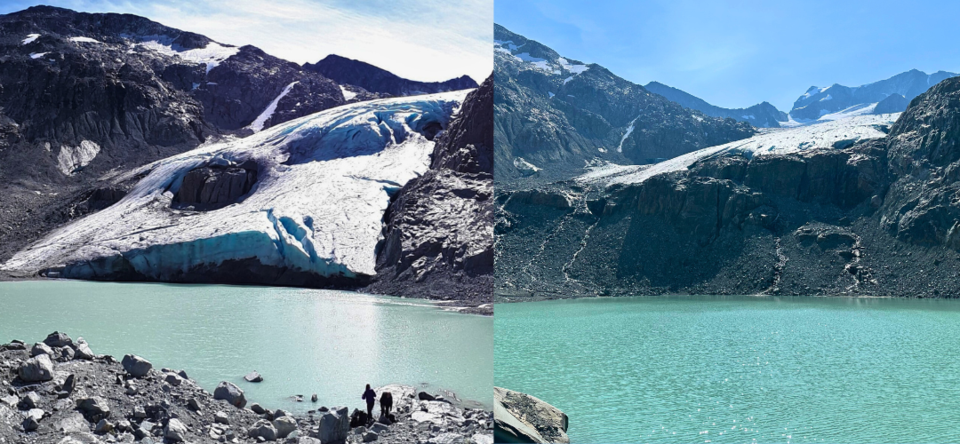”We must accept finite disappointment, but never lose infinite hope.” -Martin Luther King, Jr.
Disappointment is a regular occurrence for all of us—but the sting of unfairness bites differently when you’re a kid. You never really forget those first big disappointments in life.
One of mine came as a very young boy, when an optometrist informed me I had a colour vision deficiency known as protanopia, meaning I sometimes have trouble differentiating between certain shades of red, green and brown.
After determining this, the eye doctor gravely informed me I would never be a pilot. I had never specifically wanted to be a pilot prior to that, but the disappointment stung nonetheless.
I’ve been grounded, muddling my way through an indistinguishable swirl of greens and browns ever since.
So when reports started to come in last year about the trees in Whistler turning red, I sort of just had to take everyone’s word for it.
The result of a Western spruce budworm infestation, the great reddening has (I’m told by non-colourblind sources) only continued this year, as provincial officials work with the Cheakamus Community Forest to prepare a pest management plan.
According to Kate Mitchell, a provincial forest entomologist with the Ministry of Forests, it’s not altogether unexpected. The ministry has conducted regular aerial overview surveys of B.C.’s forests since 1999, compiling decades of historical data for insect infestation, disease, wildfire—”you name it, if it’s killing or damaging trees, we’ve been mapping it for a very long time,” Mitchell said.
Surveys would have shown a slight increase in red trees in 2023, followed by a big uptick last year, she said.
“On the Coast or even in the Southern Interior, outbreaks of Western spruce budworm are expected [about] every 20 to 25 years, and then they can persist for five or six years at a time, and then the populations kind of go down again,” she said.
More than a million hectares of forests were defoliated by Western spruce budworm this year, the vast majority—about 900,000 hectares—in the Southern Interior, Mitchell added.
It’s not unprecedented. Mitchell said the last really large outbreak occurred in 1987, and impacted 800,000 hectares of forest.
“It’s not that the ministry is not concerned … like all things which affect and potentially damage large swaths of the province, we obviously want to understand, contextualize and manage it where we need to,” she said, noting the Interior has had a pest management plan for decades, and regularly sprays to manage native defoliators like spruce budworm.
It’s important to note Western spruce budworm infestations, unlike other insects, don’t necessarily lead to tree mortality, Mitchell added.
“If you don’t know what you’re looking at, or you don’t think of bugs every day like we do, you might see them and go, ‘Oh my God, all these trees around Whistler are dead,’ right?’” she said. “That’s not true. They got munched on by caterpillars, which is what turned the leaves red and caused them to fall. Next year, if the defoliators don’t come back, those are going to flush green, and no one’s ever going to know anything happened.
“Really, the way that we deal with this is just by continually monitoring it.”
As they monitor the situation, officials are also working this year on a pest management plan, complete with public engagement, should spraying Whistler’s forests become a necessity. (The Ministry of Forests was reportedly set to provide an update on July 2, after Pique’s weekly press deadline—check back next week for more.)
It can be a difficult pill for some to swallow—watching the natural world around you change, potentially irreversibly, and knowing there’s not really anything you can do but watch it happen.
Disappointment doesn’t really begin to describe it. And it’s not just in the forests.
A recent study in the peer-reviewed journal Geophysical Research Letters found some glaciers in Western Canada and the U.S. lost 12 per cent of their mass from 2021 to 2024, doubling melt rates compared to the previous decade.
Canada Research Chair in glacier change and lead researcher on the study Brian Menounos told the Canadian Press climate change and its effects, including heat waves and changing snow patterns, are draining the “bank account” of fresh water glaciers contain.
“Doubling the amount of water that’s lost from those glaciers, we’re sort of stealing from the future,” he said. “We are just pulling and pulling away and making that bank account closer to zero and perhaps even negative. We’re not replenishing these glaciers.”
The impact is obvious on Whistler’s glaciers. According to the Whistler Naturalists, the Wedgemount Glacier saw an average horizontal recession of 13.4 metres between 2023 and 2024. Since 1973, the glacier has receded more than 700 metres. And local researchers predict the trend will continue.
“The glacier’s retreat is a stark reminder of the environmental challenges we face. Continued monitoring efforts, now passed to a new generation, offer a glimmer of hope that we can learn from the past and work towards a more positive future for this and our other local glaciers,” wrote the Whistler Naturalists’ Chloe Van Loon in the March instalment of Naturespeak. “Hope is not the conviction that glacier recession will slow or reverse in our lifetime, but the certainty that working to reduce our impact on the planet is the right thing to do, regardless of how our glaciers change.”
As ancient Greek philosopher Heraclitus said, the only constant in life is change. And change means new challenges, new perspectives, and yes, new disappointments.
But hope springs eternal—even if we can’t necessarily see it for ourselves.




